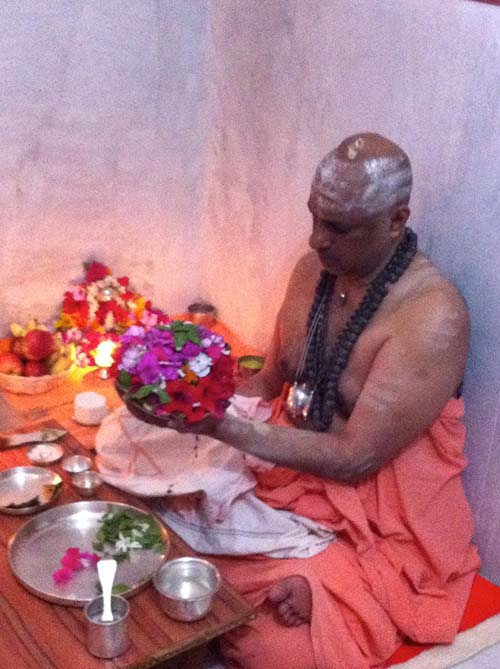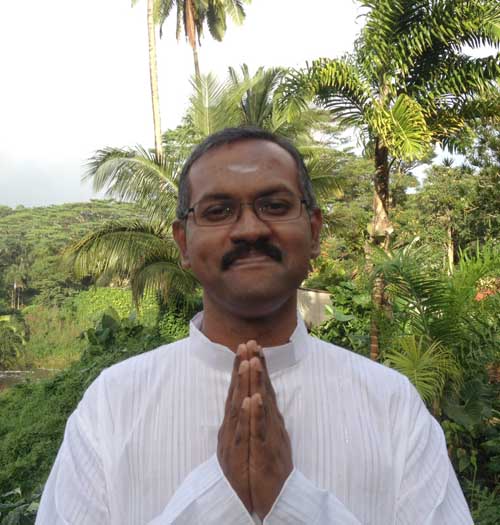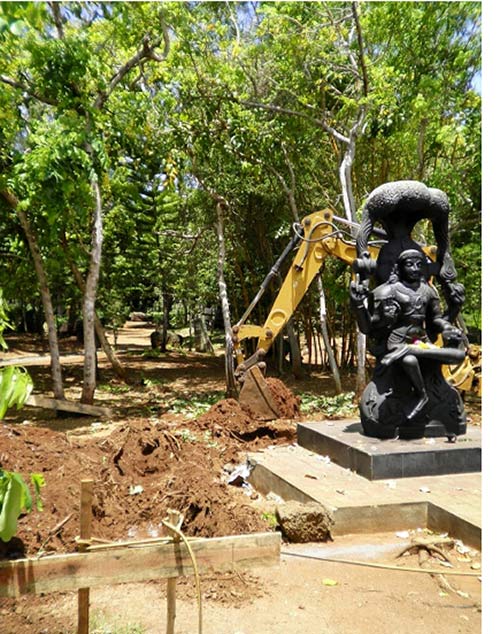The Day Begins at Suttur Matha in India with Siva Worship

The room is white, its walls and floors smooth marble. In one corner sits a quiet saint, a devoted man who dedicates his life to serve Siva and help thousands. In front of him is a small table with countless precious utensils of gleaming silver and a tray of flowers; on his right, a statue of Adi Guruji, the founder of his lineage; on his left, three priests chant. The sound of prayers and mantras is melodious, full; it reverberates in the small room. A few guests attend his private worship. The sun has not yet risen.
Meticulously, purposefully, Sri Shivarathri Desikendra Swami offers diminutive flowers to his far-removed predecessor. Though his hands are large and his fingers long, he is remarkably adroit, arranging the offerings around the murti with perfection. Monks of all ages come and go continuously, helping him light camphor, fill lamps with ghee or dispose of empty trays. Not a word is spoken. A magician, or maybe a king, swami waves his fingers subtly, moves his eyes slightly, and what he needs appears out of thin air from the hands of his well-trained disciples. No flower petal stays on the floor, no spilled drop goes unnoticed. The room is still white.
After what could have been a long time had his guests not been entranced by the puja, after having expressed his gratitude to his guru, the swami turns his attention fully to God. From a large silver pendant hanging from his neck he produces a round, black Sivalingam, the form of formless God. It is a sight to behold, a personal artifact rarely exposed to those of another tradition.
With evident joy, he handles the stone as his personal temple, as his personal treasure, as God. He pours water on it using a silver container. Then, drawing from a tray with dozens of minuscule kumbhas filled with myriad substances, he pours liquids on the stone, one by one, rinsing it, anointing the artifact with vibhuti between each ablution. The chanting has never stopped; but every so often the priests voices lose enthusiasm and luster. Swami uses his strong, loud voice, awakening the priests from their feebleness by leading the chanting with unequivocal resolve.
Holding the murti on his left hand, he uses the right one for offerings. He sometimes hides his right hand under a simple cloth with elaborate mystical symbols, twisting his fingers in mudras which should not to be seen, for they are rahasya˝ˇa secret.
Some of the monks come and prostrate during the abhishekam. They, too, open the sacred capsules over their chests, revealing more Sivalingams, and sit in a circle around their guru. They hands, outstretched, reach under swami’s hand, one above the other, forming a pillar of adoration. Water that is poured over swami’s personal Sivalingam drips down, bathing in succession the all of their lingams with water many times blessed. The monks take turns, allowing others to also come and receive the grace. Swami holds his Sivalingam on his hand for a long time as his shishyas come and go, his seemingly untiring arm steady. With his fingers he holds a specially shaped silver kumbha with an orifice at the bottom, from which water slowly bathes the stone.
Monks finally bring him a silver lotus flower with a hole in the center, which he uses around the lingam to make his hand a tray for flowers. His palm still touches the stone, in intimate contact with divinity. Everyone in the room chants the 108 names of Siva with enraptured devotion. The guru invites his monks and his guests to also offer flowers to the altar that is his hand.
Seated close together, swami and the Hawaii mathavasis wave burning camphor and flaming ghee in circles. At the highest point of the ceremony, blessings seem to feel the air like infinite inner light. God is in all, all is God.
The sun has risen. The day may begin for the head of Suttur Mutt.
Monastery Twitter Updates for 2012-01-20
- The new Hindu Temple of Fort Worth has asked Bodhinatha to guide their project. Rajni and Ranna Jani show the plans. http://t.co/0tfe6K81 #
Powered by Twitter Tools
Sadasivanathaswami and Sadhaka Satyanatha at Suttur Matha, Day 2
An eventful day at Suttur Mutt. It began with a flag-raising ceremony, a lot like what we do for new ritaus, except for the twenty nadaswara players, the five acrobats doing bicycle stunts, the five actors dressed up as warriors with play swords, the eight female drummers, the countless male drummers, the security officers mounted on horses, the ocean of people attending and, of course, the elephant. Other than those details, it was just like ours. From that we went to an intimate mass wedding with some 230 couples and their extended families.
Just before sunset, we were taken on a tour of the smaller temples near Suttur Mutt. (Photos are above) The big temple is the samadhi shrine for their Adi Guruji, whose 1052nd mahasamadhi anniversary this festival celebrates. But these other, charming little temples were built a long time ago, by the Chola kings, who were impressed by the spiritual stature of the founder of Suttur Mutt. We were told they were in a dilapidated state until the current leader of the Math renovated them, with the expertise of Ganapati Sthapati. The main mandapam, or hall, in these temples looks almost entirely new, contrasting with the ancient inner sanctums and the glorious Chola pillars eroded by time and weather, but still standing strong.
At the top of a hill, as the sun set, we visited a temple for a Deity called Giribhairav, a warrior son of Siva who likes his temples at hilltops (sounds familiar?). The main murti was sculpted in black sandstone, allowing for some details that granite cannot take, but also making us wonder if that was the original murti, since it is a more fragile material than granite. The other temples were quite similar, one to Siva and another to Vishnu, colorfully lit, clean, and always with a few locals and padasala students of even very young ages. The priests seemed content to be working in this area, under Suttur Mutt's umbrella.
While we had our adventures, Sri Shivarathri Desikendra Swamiji mostly stayed in front of the main temple, having waves people touching his feet for blessings, for hours and hours and hours on end. Quite a different way to serve humanity than ours, to be sure.
We met again today the young man who is the assigned successor to Swamiji. At age 16, Rajendra is still a student. It surprised us to learn this is a hereditary lineage. The swamis are celibate, but the successors are always chosen from among their close relatives. The current leader is the great-nephew of the previous guru. Rajendra, the heir apparent, is Swamiji's nephew.
One boon we are seeing here is that all the leading swamis invited to the event come to take their seat of honor at the specific function assigned to them and quickly leave. We are the only guests of honor staying for the whole event, which means a lot of interaction with our host Sri Shivarathri Desika Swami, who is all too happy to have his Hawaiian friends around.
Interesting and fruitful interactions with swamis and gurus from other lineages.
We have a full-time photographer and Choodie Shivaram is here working on her article for HT. It's priceless for us, as editors, to be at the site: we really get to know what this place is all about and can coordinate the article-making process in a whole new way. People share so much information with us that we would not otherwise acquire.
More later!
Monks Visit Professional Tomato and Cucumber Farmer
Yoginathaswami and SadhakaTejadevanatha flew over to the Big Island to take care of some business and to visit Kawamata Farms in Hilo.
The farm manager David Oshiro gave us a very informative tour of the farm.
Farm was started in the Mid 60s. Today they have 14 workers, 6 trainee's and 3 managers. They started growing field veggies and ran into challenges with controlling bugs that would eat the crops. Then the farm transitioned into flowers. The challenge with flowers is the high competition from other countries that have lower labor cost. Now they grow 3 Acres of hydroponic tomatoes and 3/4 of an acre of cucumbers. The tomatoes have a higher profit margin and the bugs can be controlled in a green hose
Stats of the Farm:
Tomato production: 1 million lbs a year. Cucumbers: 400,000 lbs a year
Tomatoes and Cucumbers are grown in : Coconut husk media that is imported from Sri Lanka.
Liquid fertilizer is fed to the plants through drip irrigation. The system is closely monitored by the Farm Manager. Tomatoes are spaced 5 ft apart by 12 inches
Any bugs that do find the plants are controlled organically with Neem oil. The oil is purchased from India in 55 gallon drums.
Kulapati Satya Palani Guides Tiling Work
After our Maha Ardra day festival Kulapati Satya Palani stayed on to help the monks. He is currently a top project manager for a construction firm but in his younger days he was a master tile craftsman. He kindly offered to help the Siddhidata Kulam tile their new office floor. Thanks to his amazing expertise and the team work they finished the whole job in two days. These photos are from day two and the floor is almost done.
Monastery Twitter Updates for 2012-01-19
- http://t.co/XWDPFlOy The secret? A red thumb drive. With it, anywhere you go in India you're online. Amazing experience. #
- http://t.co/lmJ7yWkg We stop at Suttur Mutt city center for lunch, & visit their tank, used as a theater each full moon. #
- http://t.co/ES1EfgtB No, it's not Photoshopped! This is Satyanatha emailing and Googling from the back seat of a car in Mysore. #
Powered by Twitter Tools
Mauritius Spiritual Park -Dakshinamurti Shrine
Monks On Mission: Mysore, Suttur Matha, Day 1
Aum Sivayanama!
We have arrived at Suttur Mutt after a perilous drive on the roads of South India. Mysore is a charming city with a village feel to it -- less than a million people live here, and in Indian numbers that is close to nothing. There are newly-paved highways around, the asphalt like carpet, where you can drive fast for a minute or two until stopping for the next herd of goats trotting down the road.
Sri Deshika Shivaratri Swami is the closest thing the city has to a de facto maharaja, creating huge hospitals, schools and institutions to help the people. The jathra, or festival, is the event of the year in this area, something the two lakh people attending look forward to. But because Mysore is not a big polluted metropolis, this feels and looks like a pure village festival, only in a grand scale. It's lovely.
Jiva and his sons are here, too. Hinduism today writer Choodie Sivaram is supposed to arrive soon.
The first stop in Mysore was paradise: a school and monastery at the feet of Chamundi hills. An oasis of tranquility untainted by the traffic din, it had quite a high vibration. Only monks, both brahmacharis and swamis, can stay there (no pictures were taken). We left soon to reach the outskirts of the city, where the festival was about to begin in the early evening.
The main temple was cheerfully decorated with lights (see photo). Sri Desikendra Shivaratri Swamiji welcomed us with genuine pleasure and a sense of kinship. The monks of Kauai were given honor seats the watch the puja that officially opened the event. A dozen priests and maybe 60 priests-in-training chanted in perfect unison to create a power no amplifier can match.
As we prepare to leave the Siva temple, our Suttur Mutt guide invites us to sit for a moment, saying, "Swami teaches us to sit after a temple visit before we leave, even if it is just for a moment." As he leaves, he walks backwards, for he was taught, he tells us, not to show your back to God, a king or the guru as you depart his presence."
They looked at the us with curiosity, and our host later explained to a crowd of very attentive priests who we were, drawing oohs and aahs when he mentioned Kauai Aadheenam's nitya vrata (eternal vow) of performing continuous worship in Kadavul temple, 24 hours a day by the monks on eight three-hour shifts. (which we have been doing for over 35 years)
The final adventure of this very long day happened when we asked to see the kitchens that feed, gratis, the 250,000 pilgrims. We thought it would be a building; how naive of us. The "kitchen" is a two-acre complex. A long row of unbelievable 800-gallon vats are heated over burning wood, day and night, to cook three meals for each pilgrim. Paramacharya Sadasivanathaswami had fun lifting a shovel full of cooked rice.
Much, much more to happen on the next few days. Aum.
Monks at Work Today
Sadhaka Haranandinatha went for a stroll this morning, catching our monks at their seva here and there. Senthilnathaswami is working on an article for the April Hinduism Today special Bali issue. This article is about animal sacrifice. "It's not an easy article to write," he says. Sivakatirswami is reviewing the iPad app "British Library; Historical Collection" for the April issue of Hinduism Today Arumuganathaswami holds a preliminary, editing copy of Growing Up Hindu, Book One of a series called Modern Stories for Hindu Youth. Santosh and Karuna Krinsky owners of New Leaf Distributors are here today.
Brahmachari Jaya is shrink-wrapping a variety pack of incense for the Minimela. Sadhaka Mayurnatha also using our laser etcher to creating wooden signs for the mini mela.
Rudiren Carpanen Pillay Joins Us from South Africa

Rudiren Carpanen Pillay, Professor of Electrical and Computer Engineering at University Of KwaZulu-Natal Durban, South Africa, is here on task force for nine days- He will be receiving his Samaya Diksha before he goes home.
From Our Gurus' Teachings
Archives are now available through 2001. Light colored days have no posts. 1998-2001 coming later.

